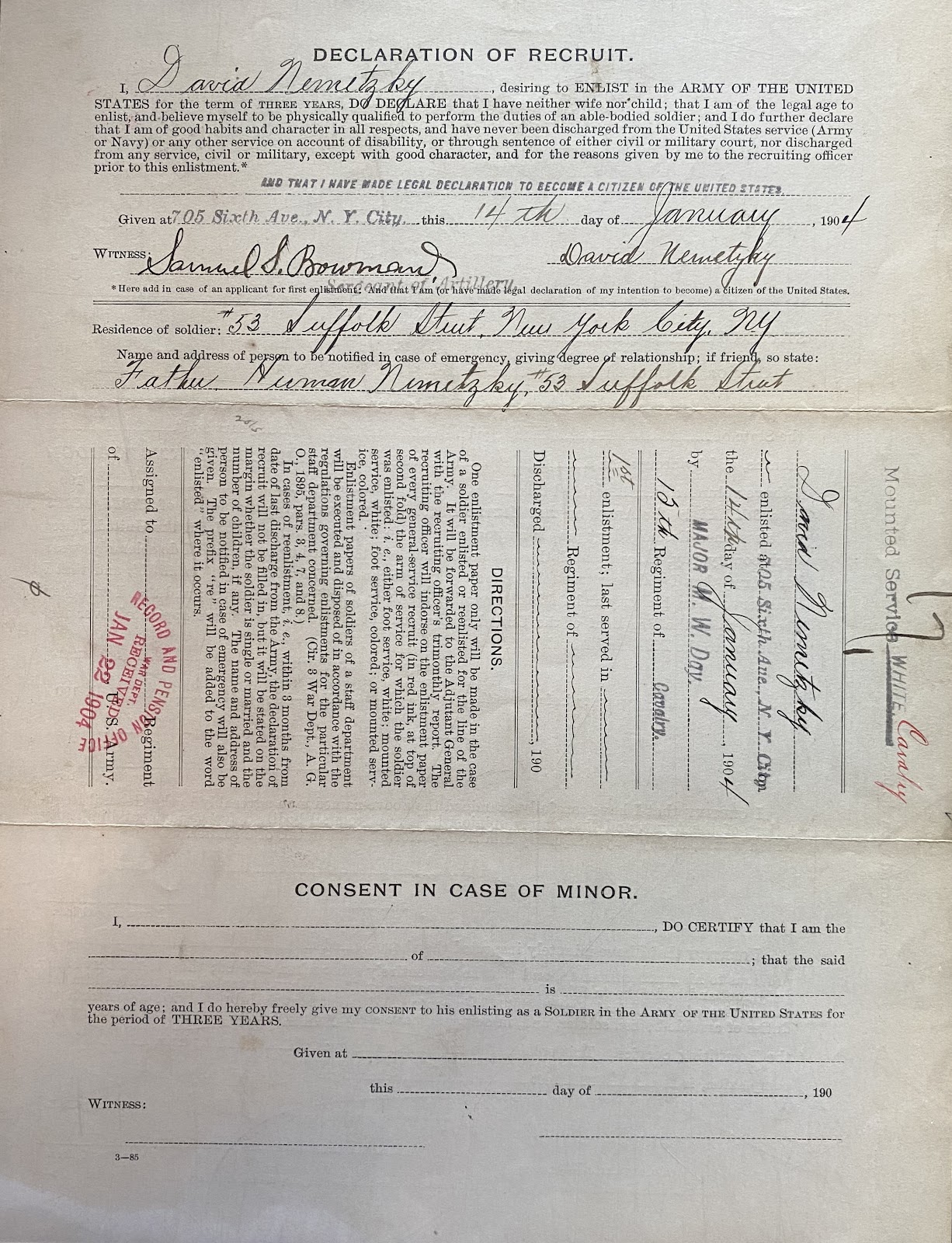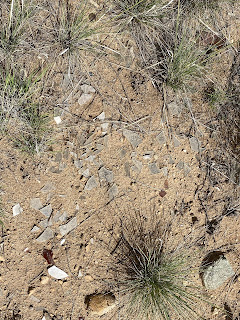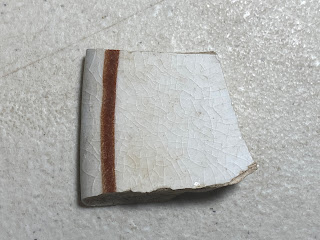For the past four days, I have conducted research at the National Archives in Washington, D.C. I have been searching out the Bi-Monthly Muster Rolls, Special Orders, and Enlistment and Personal Papers for David Nemetzky. This week has been very successful. I have found just about all of the Bi-Monthly Musters from January/February1904 through September/October 1912 for David Nemetzky. I found him in the Bi-Monthly Musters for the following units:
- Troop A, 7th Cavalry (Jan/Feb 1904 - Nov-Dec 1904)
- 99th Company, Coast Artillery (Sep/Oct 1904 - Mar-Apr 1906)
- Company B, 12th Infantry Regiment (May-Jun 1907 - Jan-Feb 1909)
As well as the following Stations while he was assigned to the Hospital Corps:
- Fort Morgan, Alabama (Mar/Apr 1906 - Nov/Dec 1906)
- Fort Moultrie, South Carolina (Nov/Dec 1906 - May/Jun 1907)
- Fort Porter New York (Jan/Feb 1909 - May/Jun 1909)
- For Wadsworth, New York (May/Jun 1909 - Jul/Aug 1909 & Mar/Apr 1911 - Nov-Dec 1911)
- Fort Howard Maryland (Jul/Aug 1909 - Sep/Oct 1909)
- Fort Ontario, New York (Nov/Dec 1911)
- USAT Logan (Nov/Dec 1911)
- Casual Detachment, Division Hospital, Manila, Philippines (Jan/Feb 1912 - Jul/Aug 1912)
- Cuartel de Espana, Philippines (Mar/Apr 1912 - May/Jun 1912)
- Tientsin, China (Jan/Feb 1912 - Sep/Oct 1912)
- Wali, China (Jul/Aug 1912 - Sep/Oct 1912)
In addition to doing a virtual consultation before coming out here, I found the printed index for the Bi-Monthly Musters available in the National Archives. Looking through the printed index, I found several Hospital Corps Musters that are filed under a series of detachment index numbers rather than the name of the Post or Station. Many of the Hospital Corps Musters for China and the Philippines are filed under these detachment index numbers. Below is the Bi-Monthly Muster for Tientsin, China for November/December 1912 that is available on Family Search. The Index number (at top) is 14354.
When I saw the list of Hospital Corps Musters Index with the detachment index numbers, I realized that the Musters for China and the Philippines would be in this part of the Musters. Below is the Bi-Monthly Muster for Tientsin, China for September/October 1912, with the Index number listed at top. (14238).
In addition to finding the musters for the Hospital Corps in China and the Philippines, I also found the Muster for the Hospital Corps traveling aboard the USAT Logan to the Philippines in December of 1911 in the Musters filed with a detached index number as well. This was a big find as I have been unable to locate a Troopship Transport List for the Logan from December 1911. Below is the image for the Muster for the USAT Logan, with the detachment number (13720) at top.
Going through the Bi-Monthly Musters, I also found information for David Nemetzky's military service while he was assigned with the 12th Infantry Regiment. This part of his military service has always been a blank page...until now. When he re-enlisted in June of 1907, he was assigned to Co. B, 12th Infantry Regiment at Fort Porter, New York. He was discharged in January of 1908 and re-enlisted for the convenience of the Government. I had always wondered why. The Bi-Monthly Musters, as well as the Special Order that is referenced on the Muster, explain why. Below is the Bi-Monthly Muster from Jan/Feb 1908 showing his assignment to the School for Bakers and Cooks.



The Special Order explains that because he had less than two years and six months remaining in his current enlistment (he had two years and five months left), he was to be discharged and re-enlisted so that he could attend the School for Bakers and Cooks at Fort Riley, Kansas. He attended this training school between January and June of 1908, spending the last month there as an Assistant Instructor. I looked for the Bi-Monthly Musters for the School for Bakers and Cooks, but did not find them. Following his return from this training, he was promoted to the rank of Cook, and held that rank until his transfer to the Hospital Corps in February of 1909. Below is the Bi-Monthly Muster from July/August 1908 showing his promotion to the rank of Cook.


He was transferred twice to the Hospital Corps. The first was in March of 1906, and the second was in February of 1909. Each Special Order authorizing his transfer both state that the transfer was per Army Regulations. The Army Regulation (first 1440, and later 1430) that authorized his transfer to the Hospital Corps reads as follows: 'Enlisted
men…may be transferred to the Hospital Corps as privates by the commander of a
division, separate brigade, or department, on the application of the surgeon of
the post or command, forwarded through military channels. The application will
state the age, character, physical condition, and habits of the soldier, date
of expiration of current enlistment, and whether made for an existing or
prospective vacancy.' Below are the Bi-Monthly Musters from Mar/Apr 1906 for 99th Company Coast Artillery & Jan/Feb 1909 for Co. B, 12th Infantry, as well as the Special Orders, showing his first two transfers to the Hospital Corps.
I had always wondered why he was transferred to the Hospital Corps...now I know why. It appears that he found he fit in best in the Hospital Corps, and helps explain why he requested assignment to the Hospital Corps upon his re-enlistment in 1911, as well as requesting transfer to the Hospital Corps from General Service Infantry following his re-enlistment in 1914.
I have already mentioned Special Orders. Special Orders were issued by Army Posts, Military Departments, and the War Department, depending on the type and nature of the order. These Special Orders were published and bound. The National Archives has many of the Special Orders available for research, and these orders help give context to many of the activities and assignments of each soldier and their military service.
Speaking of Special Orders, The National Archives also houses General Court Martial Orders. These are orders that detail the charges and outcomes of General Courts Martial. I found the General Court Martial Order for one Charles W. Adamson from 1919. He was responsible for attempting to frame David Nemetzky for misappropriation of military property in 1918 David Nemetzky was found not guilty). Looking at records that are available online, I found that Charles W. Adamson was court-martialed and demoted from Master Hospital Sergeant to Private. I have requested a copy of the General Court Martial record from the National Archives in St. Louis (I am still waiting for this record), but decided to look up the Order here in Washington, D.C. I found that Adamson was court-martialed for fraud and abusive behavior. Talk about karma coming back to bite you.
David Nemetzky faced trial by general court martial in 1904 and 1912. The National Archives provided copies of these records for me least year when they re-opened following COVID. I didn't look up these records during this visit, but I did find the general court-martial index and found both of his general courts martial listed. I also found the general court-martial for a James H. Conway in 1906. James H. Conway was charged with desertion, but only found guilty of AWOL. David Nemetzky was ordered to appear as a witness, but was not called upon to testify.
In addition to the general courts martial, David Nemetzky was also subject to a Summary Court Martial in August of 1909. Summary Courts Martial is usually used to resolve minor offenses and misconduct of enlisted personnel. The person accused must give consent for a Summary Court Martial. According to the Bi-Monthly Muster for the Hospital Corps, Fort Wadsworth for July/August 1909 (below), David Nemetzky was AWOL from August 7 to August 10, 1909. Perhaps fearing another General Court Martial, and in order to resolve the issue quickly, it appears that he gave consent for a Summary Court Martial. His punishment was to forfeit $5.00. I was unable to find any other record, including a Summary Court Martial Record, for this infraction.
I also looked up the available correspondence for David Nemetzky. Family Search has published the Carded Index for Correspondence with the Adjutant General's Office (1891-1917). I was able to find much of the available correspondence while here at the National Archives. Much of the correspondence was filed under the initial index number for David Nemetzky, (902071), while some of the other correspondence is filed under index number 1544053.
While the index references the correspondence, I found that a few pieces of correspondence that are referenced in the index no longer exist. The correspondence that does exist ranges from his request for transfer from the Cavalry to the Coast Artillery, to his illness and medical treatment in 1905, to his request for transfer to the Hospital Corps in 1914. The most interesting piece of correspondence would be from September of 1909. He requested to be discharged from the Army for the purpose of pursuing a business opportunity - a shirt manufacturing business - with his brother Jacob Nemetzky. There is a letter from his parents (pictured below), as well as from two other shirt manufacturers, requesting his discharge.
During the first half of the 20th Century, an enlisted soldier could pay his way out of his enlistment. These letters, as well as a written request submitted by David Nemetzky, were submitted to the Adjutant General's Office, and his discharge request was granted...at the cost of $80. He was granted an honorable discharge. He would later obtain his final discharge from the Army by Purchase in 1931. That discharge by purchase was only $30.
I also found and copied the Enlistment Papers for David Nemetzky while I was here. I have received copies of these records in the past, but I decided to get color copies while I was here. These are simply a contract agreeing to enlist for a period of three years, as well as a Description and Assignment card. This Card gives a physical description of the soldier, lists their next of kin, and gives the unit they are assigned to. There are four of these Enlistment Papers and Cards for him (1904, 1907, 1908 & 1911). The enlistment paper from 1904 is shown below.
I also came across a record series called Personal Papers. These are papers for enlisted personnel and are arranged by unit. I found papers for David Nemetzky in the Hospital Corps and the Coast Artillery (there was nothing for him in the Infantry or the Cavalry). The Hospital Corps only gave an additional Description and Assignment Card. The Coast Artillery contained his hospital record from when he was hospitalized in 1905 (I still need to go through the record to pull out the details). It is very likely that this was the first time this record was pulled out and looked at in over 100 years. Below is one of the pieces of correspondence from the Personal Papers file from the Coast Artillery.
There was one miss from this research trip. In addition to the Bi-Monthly Musters for the Hospital Corps, The National Archives in Washington, D.C., also houses Monthly Returns for the Hospital Corps. Family Search, Ancestry and Fold3 each have Monthly Returns for Infantry, Cavalry, Coast Artillery and Army Posts, which give a monthly accounting of each respective unit or post. Similar monthly returns for the Hospital Corps were also recorded. I was hoping to find these records and copy them as an additional source for David Nemetzky's military service. However, there is not an index for the Hospital Corps Monthly Returns to search through to find the returns I was hoping to look for, so this record set remains untouched.
Even with this one setback, this was a very productive and enjoyable trip to the National Archives. The staff here are very friendly and helpful and are a pleasure to interact with. The biggest part of this trip was finding the Bi-Monthly Musters that are housed here. Between these and those that are available on Family Search (as well as the other records I have found here as well as throughout my research), I now have put together (as complete as possible) the military record for David Nemetzky. Below is a link to the complete list of Bi-Monthly (and from July 1918 forward, Monthly) Musters for David Nemetzky that cover the entirety of his military career.
https://drive.google.com/file/d/1QTQoyT4VD_Taj3Q7odPpWT2GUPpAQlFR/view?usp=sharing
While there are many records that I won't ever be able to find because of the 1973 National Archives Fire that destroyed some 15 million Army enlisted personnel files, because of the records I have found here, as well as those that are now online, I have been able to compile his military record. Below is a link to his military record that I have compiled.







































.jpg)
.jpg)
.jpg)






























































